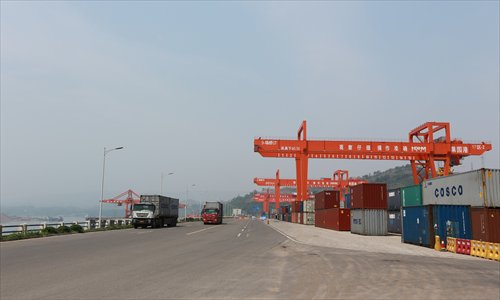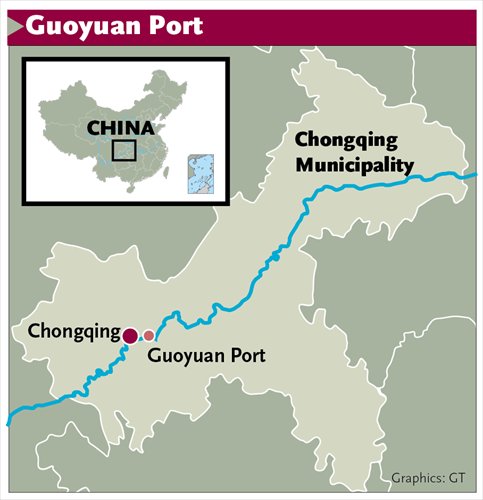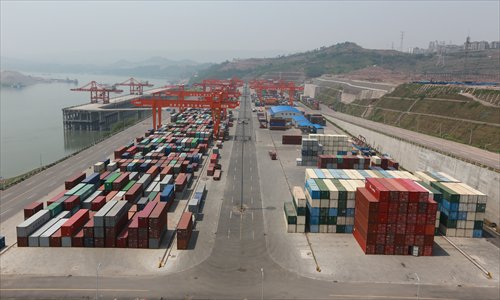HOME >> LIFE
Powers combined
By Chu Daye in Chongqing Source:Global Times Published: 2016/5/27 5:03:02

Lorries move containers at Guoyuan Port. Photo: Courtesy of Guoyuan Port
On May 23, 52-year-old Chen stood on the deck of the Minfeng, a vehicle-carrying roll-on/roll-off ship, and watched as a row of mini-vans dashed down the high banks to a hundreds-meter-long driveway to await to board his ship.These cars had just recently rolled off the assembly line. After the roughly 600 vehicle berths were full, the ship would leave Southwest China's Chongqing to sail down the Yangtze River.
Behind Chen, the mighty Yangtze River flowed quietly eastward. Toward the bank, a sprawling modern port stretching for 2.8 kilometers along the river bank and still under construction in several places was partly hidden by the morning drizzle and mist unique to the valleys along the Yangtze.
This is the Guoyuan Port, one of the key projects in Chongqing's plan to forge itself into a shipping hub on the Yangtze with direct railway connections.
Built on what is said to have once been hilly acres of citrus gardens, the port, located some 30 kilometers downstream of Chongqing's city center, is growing both in size and importance. According to the port's operator, it is now China's largest transport hub that combines river, railway and road transportation.
Covering an area of four square kilometers, the port began operations in December 2013, though infrastructure is still being added.
Development of the port has attracted attention. It was one of the few destinations Chinese President Xi Jinping visited in Chongqing during his first inspection tour in 2016. He referred to it as a "place is full of hope."
After offloading vehicles produced by domestic carmaker Changan Automobile at Wuhan, capital of Central China's Hubei Province, Chen's ro-ro ship would sail back carrying vehicles from brands such as Volkswagen, Dongfeng and Chery. Those cars would be further distributed to dealerships in Chongqing and other nearby cities.
"We sail back and forth, replenishing the stock of dealerships in Wuhan and Chongqing across different brands," Chen told the Global Times.
A total of 10.6 billion yuan ($1.62 billion) worth of investment has been poured into the construction of the port.

Guoyuan Port
Location is everything
The ro-ro wharf is only one of the many existing wharfs at Guoyuan Port. There is also a container wharf and a separate dry and bulk wharf. The port also has a logistic and transshipment center just behind the wharfs, where goods and containers can be stored for longer periods of time. And if this is not enough, railway lines stretch directly into the port area where a depot equipped with large cranes can handle shipments. The port is also 15 kilometers from the Jiangbei International Airport, adding one more dimension to its existing logistic choices.
The importance of the port becomes even more apparent when looked at on a map. The port lies at the converging point of two strategic routes of development: the Silk Road Economic Belt, under which an international rail cargo corridor links Chongqing and Europe, and the Yangtze River, along which another economic belt is under development.
Roughly 40 percent of the population in China lives along the Yangtze, which serves as a link between China's developed coastal regions and the relatively undeveloped inland.
The Silk Road Economic Belt is part of China-proposed Belt and Road initiative, a massive development plan aimed at promoting the interconnection of infrastructure, and economic and cultural exchanges between China and neighboring countries and regions along the ancient Silk Road and the Maritime Silk Road.
Chongqing is currently working to turn itself into a logistics center linking Europe, West China and Southeast Asia.
According to media reports, a total of 2 billion tons of cargoes travel the Yangtze River each year, making it the busiest inland river in the world. This cargo volume is four times that of the Mississippi and 10 times that of the Rheine.
In 2015, Guoyuan Port handled throughput of 8.68 million tons of freight, with its container wharf handling 204,000 twenty-foot equivalent units (TEUs) in 2015, or one-fifth of all container freight volume in Chongqing.
How the river has been navigated has changed over the years. In 1956, after swimming in the Yangtze River, Chairman Mao Zedong wrote a poem which envisaged the construction of a huge dam that would lead to the rise of a smooth lake among the narrow gorges.
After the Three Gorges Dam was completed in 2006, the landscape of the river traffic was changed due to the huge reservoir that formed from the Dam to Chongqing.
Chen said that nowadays currents are not a major problem for upstream journeys, but crossing the giant dam via its multiple locks may require boats line up for days at a time.
Liu Haixia, a manager at the port, told the Global Times that one of the reasons so much money has been poured into the port is due to the concrete-made, vertical container wharf, which stands dozens of meters high from bases attached to reefs in the river bed.
Such an arrangement ensures that ships can dock at the berth, regardless of the water mark of the Yangtze, Liu said. On the day of our interview, the Three Gorges Dam had been discharging huge amount of water to prepare for possible floods from the upper reaches, which caused the water mark at Guoyuan Port to drop significantly.
"But the vertical wharf ensures that the fluctuation of water marks does not affect the handling of containers at the wharf."
As many as six container ships can load/offload cargo simultaneously at the container wharf, according to Liu. This capacity can be further extended in the future.
With a displacement of 5,000 tons, ships boarding at Guoyuan are smaller than ocean-going container vessels seen in the eastern seaports of China, as their smaller displacement allows them to navigate the Yangtze. As a traditional practice, goods have to be loaded into smaller ships in Shanghai, before being shipped to cities along the Yangtze.

Container wharf and platform at Guoyuan Port, Chongqing Photo: Courtesy of Guoyuan Port
Commodity transport and trade
Having a train depot at the port has made the trade of commodities more convenient.
"Since the port's railway depot began operation in August of 2015, some 70,000 tons of coal per month have been transported from coal-producing provinces in North China," Li Xiangyuan, a manager at the Port's bulk cargo department, told the Global Times.
The port also handled 95 percent of bitumen as well as more than 80 percent of chromium traded in the Southwest China sub-market in 2015, Li said, noting that a conveyor belt is being built to allow dry bulk to be loaded or off-loaded more efficiently between the wharf and depot.
"Before, clients from Southwest China's Sichuan Province and Chongqing had to go to Shanghai or Lianyungang Port in East China's Jiangsu Province to buy these commodities, as traders are concentrated there. We hope to build Guoyuan into a platform and attract traders here. It will speed up the logistic flow and reduce costs," Li said, adding that trading volume of chromium at the port reached 500 million yuan ($76 million) in 2015.
"As goods can be stored at the warehouses at Guoyuan Port, customers can now fetch their goods in just one day, instead of placing orders 20 days to two months in advance and waiting for them to be shipped from Shanghai to Chongqing," Li said.
Tian Mingzheng, a 40-something logistics manager, supervises the operation of two warehouses at the port measuring 400,000 square meters. Traders store their purchased steel here.
The steel, of varying types, come from steel mills located virtually all over China via the railway terminal based in the port.
Tian said that a pair of cutting service lines will also be established within the year to cut cold-rolled and hot-rolled plate into different shapes required by customers at the warehouse, adding value to the existing storage service and bringing more clients to the logistic center.
Fifty-something Cheng is a driver of a heavy-haul truck. He came to the logistics center to transport steel bars to a steel retail market located in the city. His goods are steel bars about 10 meters long and several centimeters in diameter. These materials will be used to make machinery accessories such as those used by auto repair shops.
The logistic center generates revenue with the loading and off-loading of goods and also a fee for storage.
"Tens of thousands of tons of goods were handled in the warehouses since the beginning of the year," Tian said.
"As the city shifts its previous rail cargo terminal to passenger lines, the traffic at the Guoyuan railway terminal is expected to grow further."
Now the port is working on procedures to be connected with the Chongqing-Xinjiang-Europe International Railway, or Yuxinou, according to Liu.
The railway currently mainly transports IT goods and machinery to Europe and brings imported sedans back. In June 2015, about 1,000 tons of coffee beans were shipped from Vietnam to Shanghai, and then to Chongqing.
The beans were processed in plants in Chongqing and finally sold to Europe, transported via the Yuxinou, according to Qi Dan, general manager of Yuxinou (Chongqing) Logistics Co. The company handles logistics for the freight rail route.
The coffee beans were shipped by sea, river, road and rail, which demonstrates the logistics coverage of the three national initiatives that the central government is promoting: the 21st Century Maritime Silk Road, the Silk Road Economic Belt and the Yangtze River economic belt.
When the rail port at the Guoyuan Port is directly corrected with the Yuxinou, more logistic options will be made available, Liu said, noting that goods such as high-value construction materials from areas along the Yangtze could be transported to Europe via the international railway.
Posted in: Feature,